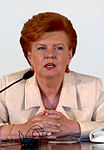United Nations Secretary-General selection, 2006
|
|
|||||||||||||||||||||
|---|---|---|---|---|---|---|---|---|---|---|---|---|---|---|---|---|---|---|---|---|---|
|
|||||||||||||||||||||
|
|||||||||||||||||||||
|
|||||||||||||||||||||
A United Nations Secretary-General selection was held in 2006 to succeed Kofi Annan, whose second term as Secretary-General of the United Nations ran until 31 December 2006. Seven candidates were officially nominated for the position.
The United Nations Security Council conducted a series of unofficial straw polls between 24 July and 2 October. South Korean Foreign Minister Ban Ki-moon led the polls from the start, emerging as the only candidate with the support of all five veto-wielding permanent members of the Security Council (P5). After the final straw poll, all of the other candidates withdrew. The Security Council conducted a formal vote on 9 October and forwarded its choice to the General Assembly, which elected Ban on 13 October.
The United Nations Charter provides for the Secretary-General to be appointed by the General Assembly upon the nomination of the Security Council. Therefore, the selection is subject to the veto of any of the five permanent members of the Security Council.
The Charter's minimal language has since been supplemented by other procedural rules and accepted practices. There is an unofficial term limit of two full terms, disqualifying Kofi Annan from re-selection. A system of regional rotation is in place to select a new Secretary-General after the previous one has served two terms. The ability of a candidate to converse in both English and French is also considered an advantage, although this is not always enforced.
...
Wikipedia



